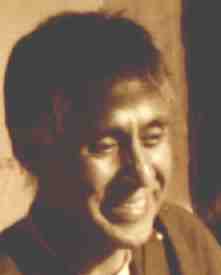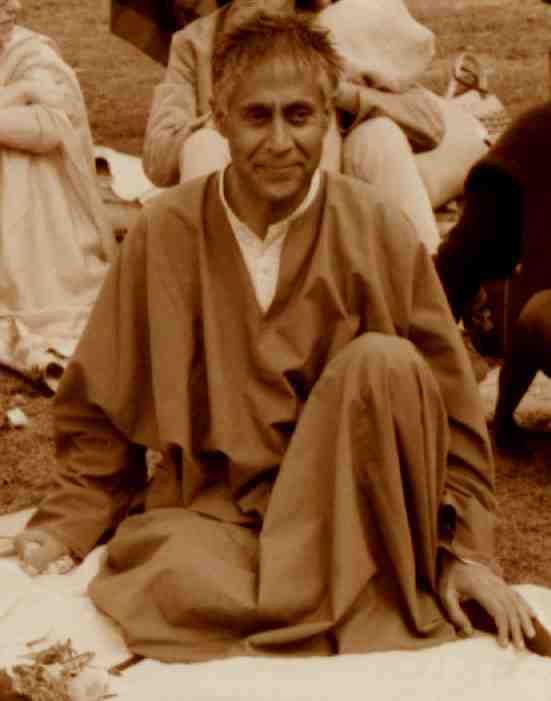
Site
Contents:
Kuda Bux; Man with X-ray Eyes
Demonstration in ESP
Demonstration in Clairaudience
Swami Lakshmanjoo; Master Over Nature
Prahlad Jani; No Food 65 yrs
Tat Wale Baba; 85 looks 35
Devraha Baba; 250+ years old
Yogi Pullavar; Levitation Photos
Yogic Flying; Author’s Experience
Coral Castle; Levitation of Large Stones
Charles F. Lutes; Clairvoyant, Healer, Lecturer
Sri Sathya Sai Baba; Man of Miracles
Martial Arts Masters of Push-Hands
Maharishi Mahesh Yogi; World Teacher, of Invincibility
Swami Lakshmanjoo -
Master Over
Laws of Nature
Vincent J. Daczynski
Chapter 4

It was late spring, 1991. Los Angeles was experiencing its fifth year of drought. The drought was so severe that water was tightly rationed. Authorities were planning to reduce water allocations to farmers in favor of industrial and residential use. Tensions between communities with competing interests were increasing. There was little hope for any immediate solution from nature since it never rains in Southern California in the summer. The Los Angeles river aqueduct, which usually had an inch or two of water, was completely dry.
It was at this time that a great Indian saint named Swami Lakshmanjoo visited Los Angeles. It was the first time in his life he had ventured outside of India. He had traveled to America to visit with those who loved him. When Laxmanjoo heard about the drought he made plans to perform Homas (fire ceremonies) for the purpose of bringing rain to Southern California.
I first met Lakshmanjoo in the Spring of 1969, while I was in India training to be a teacher of Transcendental Meditation with Maharishi Mahesh Yogi. Lakshmanjoo had invited his friend Maharishi and his students to visit with him. I was most fortunate to have been able to attend. Some twenty years later I was living in Los Angeles when a devotee of Lakshmanjoo, who knew of my prior meeting with Lakshmanjoo, called me to tell me of his arrival. He told me of Lakshmanjoo's plans to perform a Homa and invited me to attend. I was very excited to have been invited to this ceremony.
It was Sunday afternoon, June 30. I arrived at the spacious private home in the Wilshire District of Los Angeles just when the ground was being prepared for the second sacred fire ceremony. I was told about the first Homa which Lakshmanjoo had performed on Saturday June 22. Apparently, the large bonfire had frightened the neighbors who called the fire department. The arriving firemen told Lakshmanjoo that he could not build another fire unless he got a fire permit. Subsequently, Lakshmanjoo and friends had gone to the fire department and applied for a fire permit.
"To bring rain and stop the drought," Swami Lakshmanjoo had told the fire marshal when he was asked why he wanted to build a large backyard fire in a residential area.
"In that case your permit is approved," was the reply of the amused fire marshal.
At the second Homa there were about twenty of us present. Lakshmanjoo supervised the preparations and the building of the fire. Taped bhajans were played to set a pleasant atmosphere. Lakshmanjoo stated his intention for performing the ceremony. The fire was set and we all took turns walking around the fire. We then made offerings of three walnuts each, and of flowers collected from the garden trees, onto a large tray. Once the fire increased to a sufficient size the entire tray of offerings was spilled into the fire. The ceremony lasted about one hour after which we had the opportunity to meet individually with Lakshmanjoo to receive his darshan (blessings.)
Treats were prepared and provided to the guests, and everyone enjoyed some relaxed small talk. The homeowner, who had sponsored the Homa, had been with Lakshmanjoo in India. He enthusiastically raised his voice so everyone could hear. He stated that he once witnessed that Lakshmanjoo made it rain on a cloudless day. “There was not a cloud in the sky. Then suddenly a dark cloud appeared and it rained," he exclaimed. "If it rains now, that sure will be a miracle! It never rains here in the summer!" he concluded with conviction.
When Lakshmanjoo was asked by a devotee, "How is this performance going to effect rain?" Lakshmanjoo casually replied, "The flames in this fire are the same as the flames on the sun, and this small fire has sent a message to the sun. The sun in turn is controlling all the heavenly bodies, so it will pass our message on to the moon, because it is the moon’s responsibility to create rain. It may take some time, but rain will come since we did this ceremony in good faith and without selfish motive."
I went home that evening wondering when it would rain. A couple of days went by and nothing unusual occurred. Then after a couple of more days there was a mild drizzle in Los Angeles with a downpour in Santa Barbara. The drizzle was headline news since it was most unusual for it to have even drizzled at this time of the year in Los Angeles. Then over the next few days, by July 8, it began to rain more heavily in Los Angeles. Local newspapers carried the record-breaking rainfall story on their front pages. The Daily News stated,
The weather specialist was wrong! Within several days it rained some more, and more, and more. Each day brought a greater intensity of rain, drenching the area from Santa Barbara to the Mexico border. It continued raining for over a month with great intensity! During this time a twister hit downtown Los Angeles and about a week later a typhoon hit in the Oxnard area. The Sepulveda dam overflowed, flooding the Sepulveda dam recreation basin. Some two-dozen people, who were hanging on to the top branches of trees, had to be rescued out of the ravaging floodwaters by helicopters. Burbank Boulevard flooded, trapping surprised motorists who also had to be rescued. For several days, at the peak of the storm, the Los Angeles river aqueduct was overflowing at its maximum height of about twelve feet and was racing towards the ocean at thirty miles per hour! The weather specialist stated that we were experiencing a rare tropical storm. Rare indeed! It hadn’t rained like this in Southern California in
recorded history. The drought was over.
Here is another account of Lakshmanjoo's mastery over the laws of nature as reported by one of his devotees.
Lakshmanjoo was a highly developed spiritual master who devoted his life to the study and mastery of the relatively unknown system of philosophy called Kashmir Shaivism. By the age of nineteen he had his first clear glimpse of God Consciousness. It was that touch of the Divine that impelled him to take a vow of lifelong celibacy and dedication to the realization of the highest truth. At an early age, as a result of his intense spiritual practice, Lakshmanjoo had achieved the eight great siddhi powers, mentioned in the ancient literature of Indian philosophy.
These siddhi powers are incomprehensible to the Western civilized man’s purely materialistic interpretation of the Universe. However, the Universe is not material after all. It is a projection of consciousness. Siddhi powers are gained by bringing one's awareness to causation, where the mind is most powerful and where the laws of nature reside. One can then create extraordinary outcomes in the projected so-called 'material world.' A God-realized yogi's mind is expanded whereby his awareness is always established at the source of causation. For such a yogi all the laws of nature reside within his conscious mind. He is one with nature. All of nature is his nature. Therefore, he always has the laws of nature at his command.
Lakshmanjoo was one of a few rare yogis who reached such an elevated status. He used his siddhi powers only to help humanity, and did so without seeking fame or reward for his service. However, for him, the use of siddhi powers was trifling. To him the greatest miracle in God's creation was to witness the transformation of an individual, experiencing a limited state of life, into an enlightened aspirant, well on the path to realizing his or her own divinity. With an inner conviction that God realization was the absolute pinnacle of human achievement, and that this realization was available to one and all, irrespective of caste, creed, color or gender, Lakshmanjoo dedicated his life to the teaching of Kashmir Shaivism that could easily make this goal realizable.
In the oral tradition of Kashmir Shaivism, Swami Lakshmanjoo was the last living master in a line of philosophers who date back almost 5,000 years. As one of the twentieth century’s greatest philosopher-saints, Swami Lakshmanjoo became the living essence of the teachings of Kashmir Shaivism. It was his destiny to become Self-realized and leave a legacy of knowledge for those who would come after his passing. Lakshmanjoo considered the teachings of Kashmir Shaivism to be about God and of humanity's relationship to God. Therefore, they were available for everyone. Kashmir Shaivism, in Lakshmajoo’s own words is "universal thought."
Soon after his trip to Los Angeles, Swami Lakshmanjoo took Mahasamadhi. Subsequently, his dearest devotees founded the Universal Shaiva Fellowship in order to carry on the tradition and knowledge expounded by their Great Master.
…the first July 8, to have rain in Los Angeles since the National Weather Service began keeping records in 1877...
Rainfall was reported from Ventura County to the Mexican border...
Rowe (weather specialist) said that she hoped Southern Californians enjoyed the wet weather because rain isn’t expected to drop by the area for a while.
For the complete news story please see: July Puddles?Lakshmanjoo was having lunch with a family, who lived adjacent to his small ashram. It was his habit to regularly invite people for lunch and serve them Kashmiri rice and delicious vegetarian food grown in his own garden and prepared in his own kitchen. On this particular occasion, in the middle of lunch, the whole room started shaking. As earthquakes were common in Kashmir those present just sat quietly, waiting for the tremors to pass, as they usually did. But instead the tremors became more violent and showed no sign of abating. Sensing that his guests were becoming alarmed Lakshmanjoo stood up and stomped his right foot forcefully to the floor. At that very instant the earthquake stopped. Lakshmanjoo again sat down and resumed his lunch, as all present looked on in amazement. He casually called to his cook to bring more vegetables for everyone.